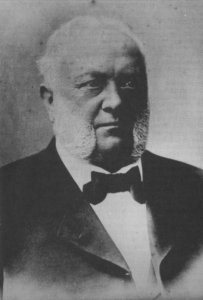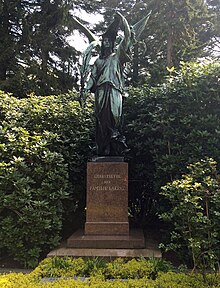Carl Laeisz
Carl Heinrich Laeisz (pronounced: "Leiß", born April 27, 1828 in Hamburg ; † March 22, 1901 ibid) was a German merchant and shipowner .
Life
Laeisz was the son of the shipowner Ferdinand Laeisz and his wife Johanna Ulrike Catharina Creutzburg. After finishing school, Laeisz completed a commercial apprenticeship at EC Schramm & Co. in Bremen , followed by several extensive study trips through Great Britain, France and America.
On March 1, 1852, he joined his father's company, F. Laeisz , as a partner . As a capable businessman, he soon brought the family business with the trading, shipping and insurance divisions into an outstanding position in Hamburg's economic life.
Laeisz married Sophie Christine Knöhr (1831–1912) in 1852, a daughter of the shipbroker Christian Ludwig Knöhr. With her he had a son, Carl Ferdinand Laeisz . Sophie Laeisz was nicknamed "Poodle" because of her frizzy hair or her hairstyle, which Laeisz named the company's second ship in 1857 and which established the tradition of giving all ships a "P" name (see Flying P-Liner ) .
In addition to family and company, Laeisz was involved in the Philharmonic Society , on whose board he was from 1899 to 1901.
Carl Laeisz ran the company founded by his father with great success; He was also a co-founder of the Hamburg-South American Steamship Company in 1871, where he took over the management of the Board of Directors in 1887 after the death of his father. He played a key role in the founding of several shipping companies, such as the steamship shipping company "Hansa" (1883), which was sold to Hapag in 1892 , the German-Australian Steamship Company (1888), the German Levante Line (1889) and the Participates in the German East Africa Line (1890). Carl Laeisz was also a major shareholder in Hapag and a sponsor of Albert Ballins .
As modern as these companies were, their own shipping company continued to use sailing ships , the Flying P-Liners, famous for their robustness, speed and reliability . It was precisely these steel ships, whose standing and moving goods increasingly consisted of steel cables and chains and which sailed as saltpeter clippers around Cape Horn to Chile and back, brought the Laeisz family great international reputation. “My ships can and should make fast journeys,” was his instruction to the captains. At the suggestion he gave the order for a five-masted full ship, the Prussians , whose construction and completion neither he nor his son saw.
Laeisz worked for various insurance companies and banks. He was a member of the supervisory board of the Assecuranz-Union from 1865, the North German Insurance Company, the Janus Insurance and the Vereinsbank .
Laeisz volunteered as a member of the stamp deputation in 1861 and 1862 and as a tax appraiser from 1861 to 1864. The Hamburg Parliament belonged Laeisz 1862 as a representative of the stamp deputation. In 1878 he was elected by the merchants to the commission for the seaman's fund and in 1882 was an assessor at the maritime office.
Laeisz was a founding member of the “Auf dem Uhlenhorst” ice skating club, which was one of the first German clubs to include tennis in its program. Laeisz donated the winner's cup for the first staging of the German tennis championships in Hamburg in 1892.
Carl Laeisz died on March 22, 1901 in Hamburg at the age of almost 73. In his will he had donated a new music hall, the Laeiszhalle , to the Philharmonic Society . His widow Sophie Laeisz increased the foundation further. It also became one of the founders of the Hamburg Scientific Foundation (founded in 1907) in 1906/07 .
photos
See also
- Laeisz (family)
- F. Laeisz (Company)
- Flying P-Liner (famous sailing ships from F. Laeisz)
Individual evidence
-
↑ according to information from today's company because of their frizzy hair: company. Growth and social responsibility. “From 1850 to 1862” on F. Laeisz's website (accessed December 22, 2015)
according to other information because of her hairstyle: z. B. jomi (September 3, 2003). Sophie Laeisz. Hamburger Abendblatt . (accessed March 3, 2008) - ↑ Gillmeister, H .: Cultural history of tennis. Wilhelm Fink Verlag, Munich 1990, ISBN 3-7705-2618-X , p. 284
- ↑ The early donors on the website of the Hamburg Scientific Foundation (accessed December 22, 2015)
literature
- Gerhard Ahrens: Laeisz, Carl. In: New German Biography (NDB). Volume 13, Duncker & Humblot, Berlin 1982, ISBN 3-428-00194-X , p. 399 f. ( Digitized version ).
- Rolf Geffken : Jammer & Wind - An Alternative History of German Shipping , Hamburg 1985, ISBN 3-924621-01-2 , p. 33 f.
- Johannes Gerhardt: Carl and Sophie Laeisz. A biographical approach to the times and themes of your life . (Patrons of science). Hamburg 2007, ISBN 978-3-937816-36-4 ( full text as PDF)
- Susanne Wiborg and Klaus Wiborg: 1847–1997. Our field is the world - 150 years of Hapag-Lloyd . Festschrift published by Hapag Lloyd AG, Hamburg 1997 ISBN 3-921305-36-5
- Wilhelm Heyden: The members of the Hamburg citizenship 1859–1862 . Festschrift for December 6, 1909. Herold in Komm., Hamburg 1909, p. 186-188 .
| personal data | |
|---|---|
| SURNAME | Laeisz, Carl |
| ALTERNATIVE NAMES | Laeisz, Carl Heinrich (full name) |
| BRIEF DESCRIPTION | German merchant and shipowner |
| DATE OF BIRTH | April 27, 1828 |
| PLACE OF BIRTH | Hamburg |
| DATE OF DEATH | March 22, 1901 |
| Place of death | Hamburg |







